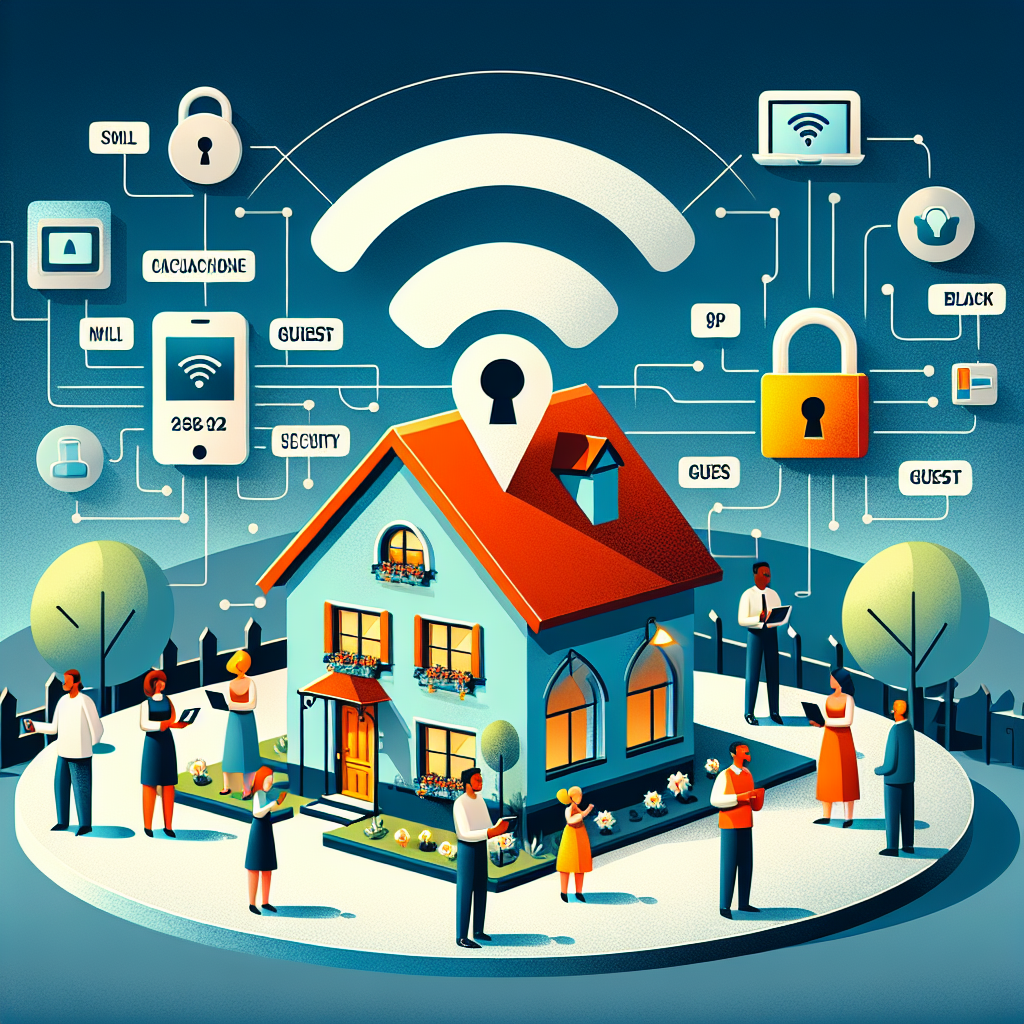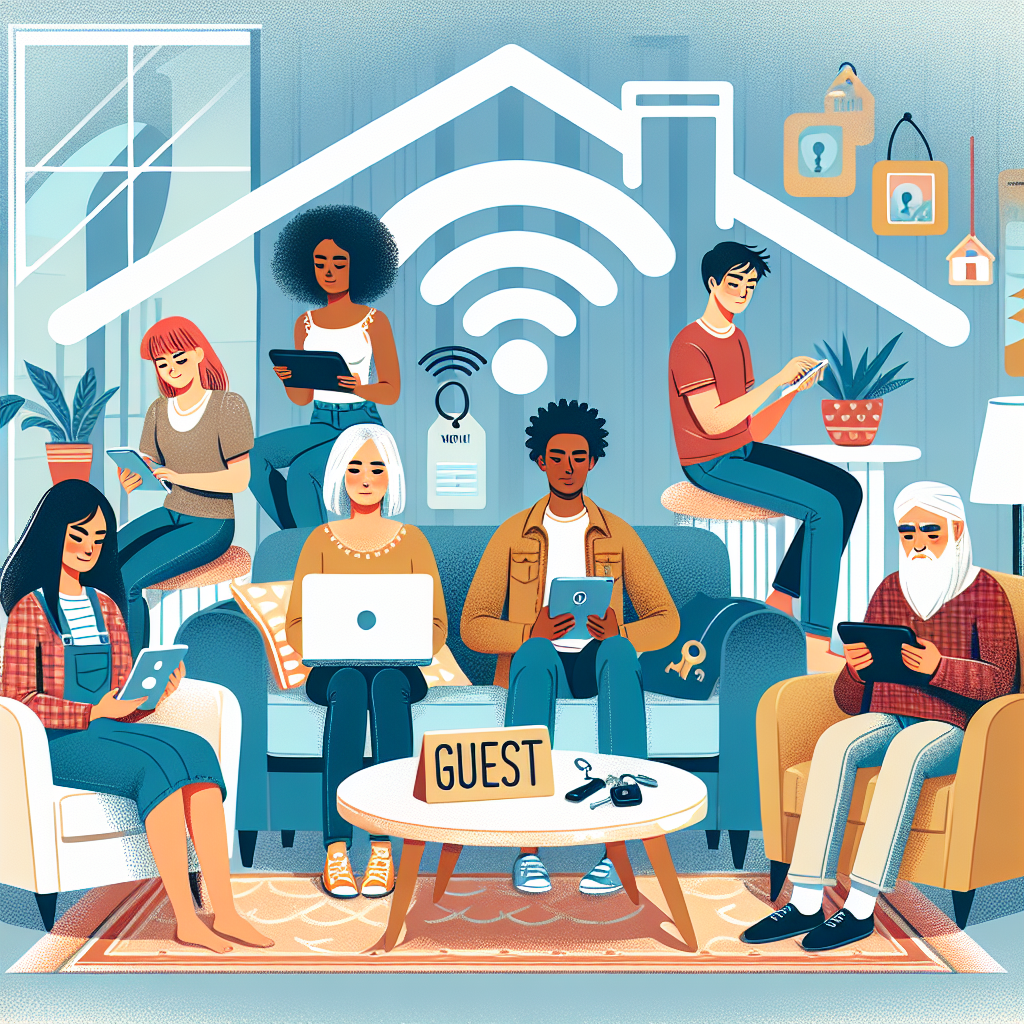In this modern era dominated by technology, having home internet with guest access has become a necessity rather than a luxury. This setup allows you to provide convenient and secure internet access to visitors without compromising the security of your own network. By exploring the benefits and security features of home internet with guest access, you can ensure that your personal information remains safe while also offering a seamless online experience to your guests. From enhancing connectivity to protecting your privacy, this innovative solution offers a plethora of advantages that make it a must-have for any household.
Understanding Home Internet with Guest Access
In the realm of modern technology, home internet with guest access refers to the capability of a household to provide temporary Wi-Fi connectivity to visitors or individuals without sharing the primary network password. This arrangement allows guests to access the internet without compromising the security of the primary network. By creating a separate network specifically for guests, homeowners can maintain control over their personal data and devices while still offering convenient connectivity to visitors.
Importance of providing guest access in a home network
- Enhancing security: By segregating guest devices onto a separate network, homeowners can minimize the risk of unauthorized access to sensitive information or devices connected to the primary network.
- Convenience for guests: Offering guest access allows visitors to connect to the internet seamlessly without requiring them to disclose personal passwords or compromising the security of their own devices.
- Bandwidth management: Allocating a separate network for guests ensures that their internet usage does not interfere with the performance of the primary network, providing a smoother online experience for all users.
Differentiating Home Internet from Guest Access
Understanding Home Internet with Guest Access
- Primary Home Internet Connection
- The primary home internet connection refers to the main network that is set up to provide internet access to the residents of a household. This connection is typically secured with a password and is used for the personal devices and online activities of the homeowners.
- It is the network that allows devices within the home, such as computers, smartphones, tablets, and smart home devices, to connect to the internet and communicate with each other.
- The primary home internet connection is usually set up and managed by the homeowners, who have control over the network settings and access permissions.
- Guest Access in a Home Network
- Guest access in a home network is a feature that allows visitors, such as friends, family, or guests, to connect to the internet without having access to the main home network. This separate network is often created to ensure the security and privacy of the primary network.
- It provides a designated Wi-Fi network specifically for guests to use, keeping their devices isolated from the homeowner’s personal devices and data. This segregation helps prevent unauthorized access to sensitive information and protects the home network from potential security threats.
- Guest access typically comes with restrictions, such as limited bandwidth or time restrictions, to ensure that guests can use the internet while safeguarding the performance and security of the primary home network.
Benefits of Guest Access in Home Internet

– Increased convenience for guests
Providing guest access to the home internet network offers a heightened level of convenience for visitors. Guests no longer have to rely on their mobile data or ask for the main network password, enabling them to seamlessly connect their devices to the internet. This ease of access fosters a more welcoming environment for guests and eliminates any potential awkwardness or inconvenience associated with requesting network credentials.
- Maintaining security for primary network
One of the key advantages of enabling guest access on a home internet network is the ability to safeguard the security of the primary network. By segregating guest users onto a separate network, homeowners can mitigate the risk of unauthorized access to sensitive information or devices connected to the main network. This segregation ensures that guests can enjoy internet connectivity without compromising the integrity and privacy of the primary network.
- Allowing guests to use the internet without sharing the main network password
Guest access functionality allows hosts to extend the courtesy of internet connectivity to visitors without divulging their main network password. This not only enhances the security posture of the home network but also prevents the need for frequent password sharing, which can be cumbersome and potentially compromise network security. Guests can enjoy the benefits of online connectivity without disrupting the privacy and integrity of the primary network, thereby creating a win-win situation for both hosts and visitors.
Convenience for Guests
### Convenience for Guests
- Easy access to internet services: Providing guest access to home internet allows visitors to quickly and conveniently connect to the Wi-Fi network without having to ask for the main password. This eliminates the need for guests to go through the hassle of typing in a complex password or waiting for the homeowner to manually enter it for them. Guests can simply select the designated guest network and input a temporary password provided by the homeowner, granting them immediate access to the internet.
- Flexibility in connecting multiple devices: Guest access to home internet offers the convenience of connecting multiple devices simultaneously. Guests can connect their smartphones, laptops, tablets, and other gadgets to the guest network without impacting the security or performance of the homeowner’s primary network. This flexibility enables guests to stay connected and productive during their visit without any limitations on the number of devices they can use to access the internet.
Security for Primary Network
Benefits of Guest Access in Home Internet
- Isolation of guest devices from personal data
By providing guest access to your home internet, you create a separate network for visitors to use. This separation is crucial as it prevents guest devices from directly interacting with or accessing any personal or sensitive data stored on devices connected to the primary network. This isolation significantly reduces the risk of unauthorized individuals gaining access to confidential information, such as financial records, personal documents, or sensitive work-related files.
- Prevention of unauthorized access to sensitive information
One of the key advantages of implementing guest access on your home internet is the enhanced security it offers to the primary network. Without guest access, visitors might inadvertently or intentionally connect to the primary network, potentially compromising its security. By segregating guest devices onto a separate network, you establish a barrier that limits their reach and shields your primary network from potential security breaches. This preventive measure significantly reduces the chances of unauthorized access to sensitive information, protecting your personal data and ensuring a safer online experience for all users.

Implementing Guest Access in Home Internet
In setting up guest access on a router, individuals can create a separate network specifically designated for guests. This segregation ensures that visitors can enjoy internet connectivity without compromising the security of the primary network utilized by the household members. By creating a distinct network for guests, homeowners can prevent unauthorized access to sensitive data and devices connected to their main network.
Setting up Guest Access on a Router
- To establish guest access, users typically access their router’s settings through a web browser by entering the router’s IP address.
- Within the router settings, there is usually an option to create a guest network, which allows for the configuration of specific parameters such as network name (SSID) and password.
- Once the guest network is created, individuals can customize settings such as bandwidth limitations or time restrictions to manage the guest users’ internet usage effectively.
Configuring Network Settings for Guest Users
- When configuring network settings for guest users, it is essential to enable security features such as WPA2 encryption to safeguard the guest network from potential cyber threats.
- Additionally, setting up a guest network often involves isolating guest devices from accessing shared files or other devices on the primary network, enhancing overall network security.
- Regularly updating the router’s firmware and guest network settings is crucial to address any security vulnerabilities and ensure a safe browsing experience for both residents and guests.
Setting Up Guest Access
Implementing Guest Access in Home Internet
Setting up guest access on a home internet network is a crucial step in ensuring a secure and efficient online environment for both residents and visitors. By creating a separate network specifically designated for guests, homeowners can protect their personal data and devices while still offering connectivity to visitors. The process of setting up guest access typically involves the following steps:
- Accessing router settings: To begin the setup process, the user must access the router settings. This can usually be done by typing the router’s IP address into a web browser and entering the login credentials. Once inside the router settings, the user can navigate to the appropriate section for creating a guest network.
- Creating a separate guest network: Within the router settings, there is usually an option to set up a separate guest network. This feature allows the homeowner to establish a distinct network that is isolated from the main home network. By creating this separation, guests can enjoy internet access without compromising the security of the primary network.
- Assigning a unique SSID and password for guest access: When setting up the guest network, it is essential to assign a unique Service Set Identifier (SSID) and password. The SSID is the name of the network that guests will see when attempting to connect, while the password is the key they will need to enter to access the network. By creating a unique SSID and password specifically for guest access, homeowners can control who has permission to connect to the guest network and prevent unauthorized users from gaining access.
Configuring Network Settings
When implementing guest access in home internet, configuring network settings plays a crucial role in ensuring both convenience and security. By customizing these settings, homeowners can control the level of access guests have to their network. Some key aspects of configuring network settings include:
- Limiting guest access to specific devices or bandwidth: Homeowners can set up their network in a way that restricts guest access to specific devices or limits the amount of bandwidth available to them. This can help prevent guests from consuming excessive resources or accessing sensitive information on other devices connected to the network.

– Enabling guest access with time restrictions for added security: Another important aspect of configuring network settings for guest access is the ability to set time restrictions. By defining specific time periods during which guests can access the network, homeowners can reduce the risk of unauthorized access outside of designated hours. This feature is particularly useful for temporary guests or situations where limited access is preferred.
Security Considerations for Home Internet with Guest Access
- Guest networks can pose significant risks to the overall security of a home network. When left unsecured, these networks can provide an entry point for malicious actors to gain unauthorized access to sensitive information and devices.
- Unsecured guest networks are particularly vulnerable to attacks such as eavesdropping, data interception, and unauthorized access to connected devices. Without proper security measures in place, guest users could potentially compromise the integrity and confidentiality of the primary network.
- It is paramount to secure guest access to safeguard the primary network from potential security breaches. Implementing measures such as unique guest network passwords, network segmentation, and isolation can help mitigate the risks associated with allowing guest users onto the home network.
Risks of Unsecured Guest Networks
- Potential for unauthorized access to personal data
Unsecured guest networks pose a significant risk as they can potentially expose personal data to unauthorized individuals. Without proper encryption and security measures in place, sensitive information such as login credentials, financial details, and personal documents transmitted over the network could be intercepted by malicious actors. This can lead to identity theft, financial fraud, and other forms of cybercrime. - Increased vulnerability to cyber threats and malware attacks
Another risk associated with unsecured guest networks is the heightened vulnerability to various cyber threats and malware attacks. Guests connecting to the network may unknowingly introduce malware-infected devices, which can spread across the network and compromise the security of all connected devices. Additionally, without proper network segmentation and access controls, guests could inadvertently access shared folders, printers, or other devices on the home network, further increasing the risk of unauthorized access and data breaches.
Securing Guest Access
- Using strong encryption methods for guest networks
When setting up guest access on a home internet network, it is crucial to utilize strong encryption methods to protect the data transmitted over the network. One common encryption protocol used for guest networks is WPA2, which provides a high level of security by encrypting the traffic between devices connected to the network. By implementing strong encryption, homeowners can prevent unauthorized users from intercepting sensitive information and ensure that their guest network remains secure.
- Regularly updating router firmware for security patches
Another important aspect of securing guest access on a home internet network is to regularly update the router firmware to install the latest security patches. Manufacturers often release firmware updates to address vulnerabilities that could be exploited by cyber attackers. By staying up to date with these updates, homeowners can strengthen the security of their guest network and mitigate the risk of potential security breaches. It is advisable to enable automatic updates on the router to ensure that the latest security patches are applied promptly.
FAQs for Exploring the Benefits and Security of Home Internet with Guest Access
Can I set up guest access on my home internet network?
Yes, most modern routers come equipped with the option to set up a separate guest network for visitors to connect to. This allows guests to access the internet without having access to your personal devices or network settings. It is a convenient way to provide internet access to guests while maintaining the security of your personal network.
What are the benefits of having guest access on my home internet network?
One of the main benefits of having guest access on your home internet network is that it allows you to provide internet access to visitors without compromising the security of your personal devices and files. It also helps to prevent guests from accidentally or intentionally accessing sensitive information on your network. Additionally, having guest access can help to alleviate network congestion by separating guest traffic from your personal network usage.
How can I ensure the security of my home internet network with guest access?
To ensure the security of your home internet network with guest access, it is important to set up a strong password for your guest network. Additionally, you can enable network encryption, such as WPA2, to protect against unauthorized access. It is also a good idea to regularly check for firmware updates for your router to ensure that any security vulnerabilities are patched. By following these steps, you can help to keep your home internet network secure while still providing guest access.